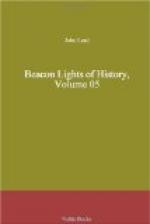But the sorrows of the pious pilgrims did not end when they reached the Holy Land. Jerusalem was then in the hands of the Turks and Saracens (or Orientals, a general name given to the Arabian Mohammedans), who exacted two pieces of gold from every pilgrim as the price of entering Jerusalem, and moreover reviled and maltreated him. The Holy Sepulchre could be approached only on the condition of defiling it.
The reports of these atrocities and cruelties at last reached the Europeans, filling them with sympathy for the sufferers and indignation for the persecutors. An intense hatred of Mohammedans was generated and became universal,—a desire for vengeance, unparalleled in history. Popes and bishops weep; barons and princes swear. Every convent and every castle in Europe is animated with deadly resentment. Rage, indignation, and vengeance are the passions of the hour,—all concentrated on “the infidels,” which term was the bitterest reproach that each party could inflict on the other. An infidel was accursed of God, and was consigned to human wrath. And the Mohammedans had the same hatred of Christians that Christians had of Mohammedans. In the eyes of each their enemies were infidels; and they were enemies because they were regarded as infidels.
Such a state of feeling in both Europe and Asia could not but produce an outbreak,—a spark only was needed to kindle a conflagration. That spark was kindled when Peter of Amiens, a returned hermit, aroused the martial nations to a bloody war on these enemies of God and man. He was a mean-looking man, with neglected beard and disordered dress. He had no genius, nor learning, nor political position. He was a mere fanatic, fierce, furious with ungovernable rage. But he impersonated the leading idea of the age,—hatred of “the infidels,” as the Mohammedans were called. And therefore his voice was heard. The Pope used him as a tool. Two centuries later he could not have made himself a passing wonder. But he is the means of stirring up the indignation of Europe into a blazing flame. He itinerates France and Italy, exposing the wrongs of the Christians and the cruelties of the Saracens,—the obstruction placed in the way of salvation. At length a council is assembled at Clermont, and the Pope—Urban II.—presides, and urges on the sacred war. In the year 1095 the




